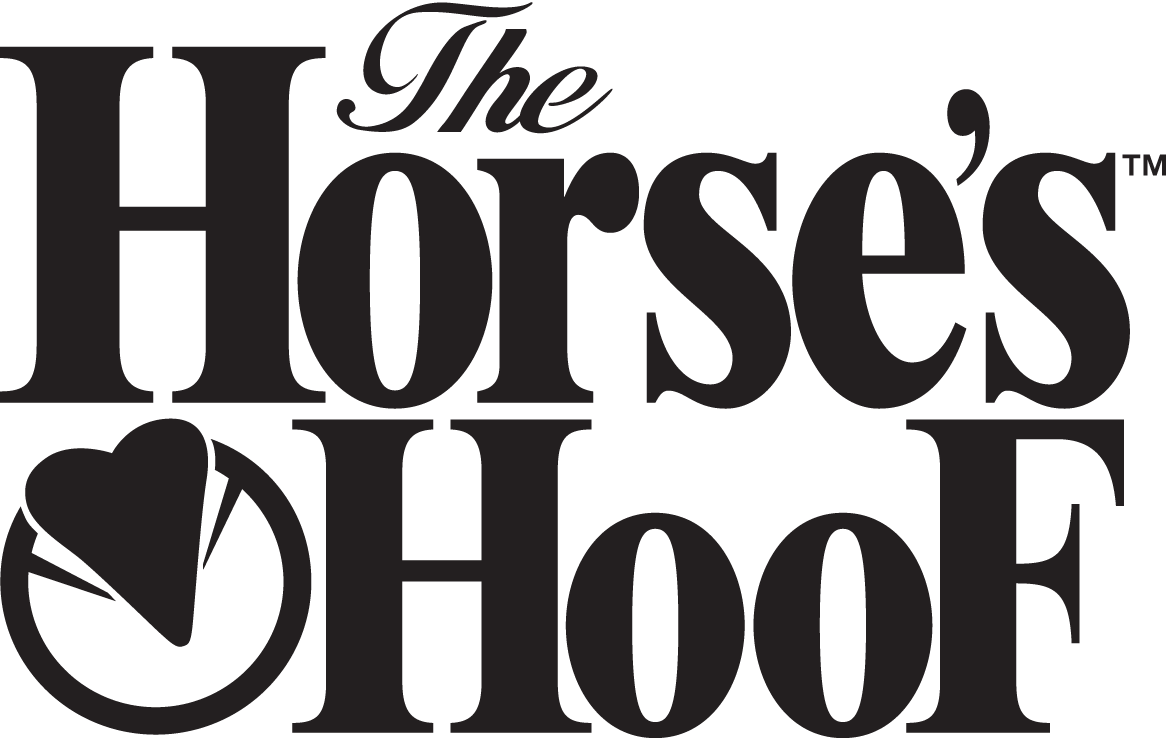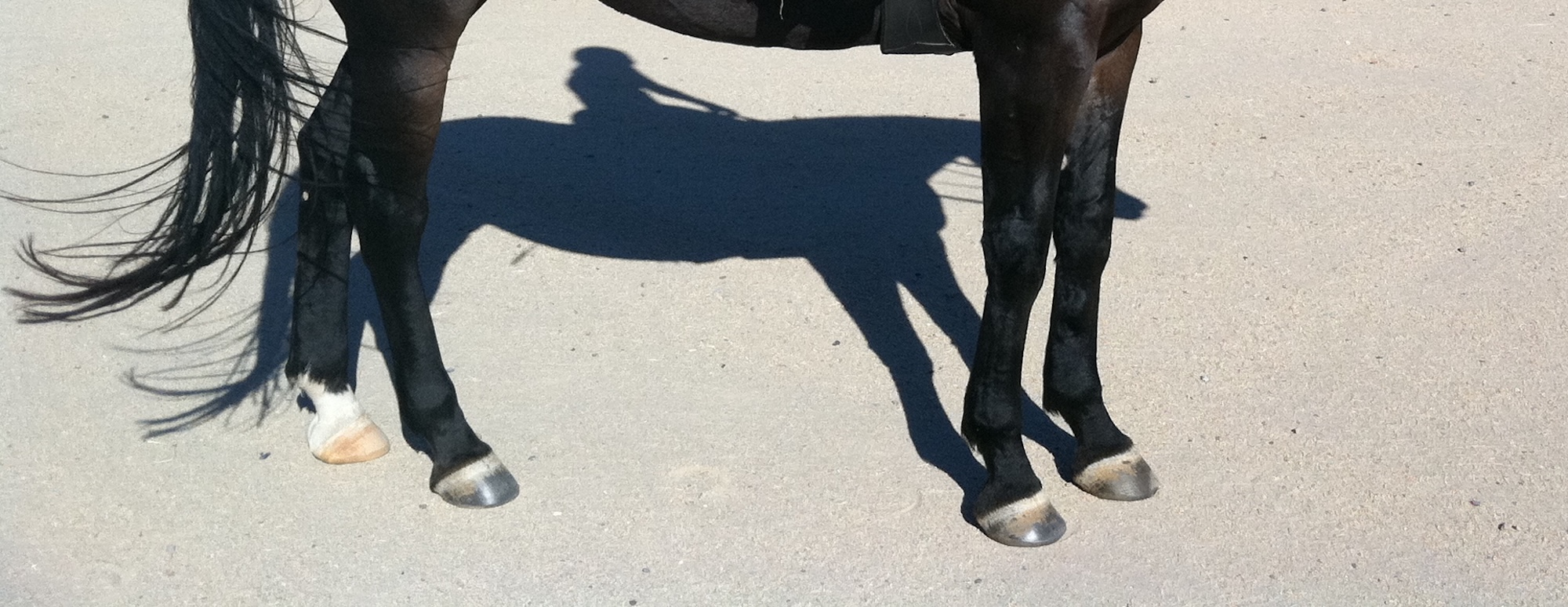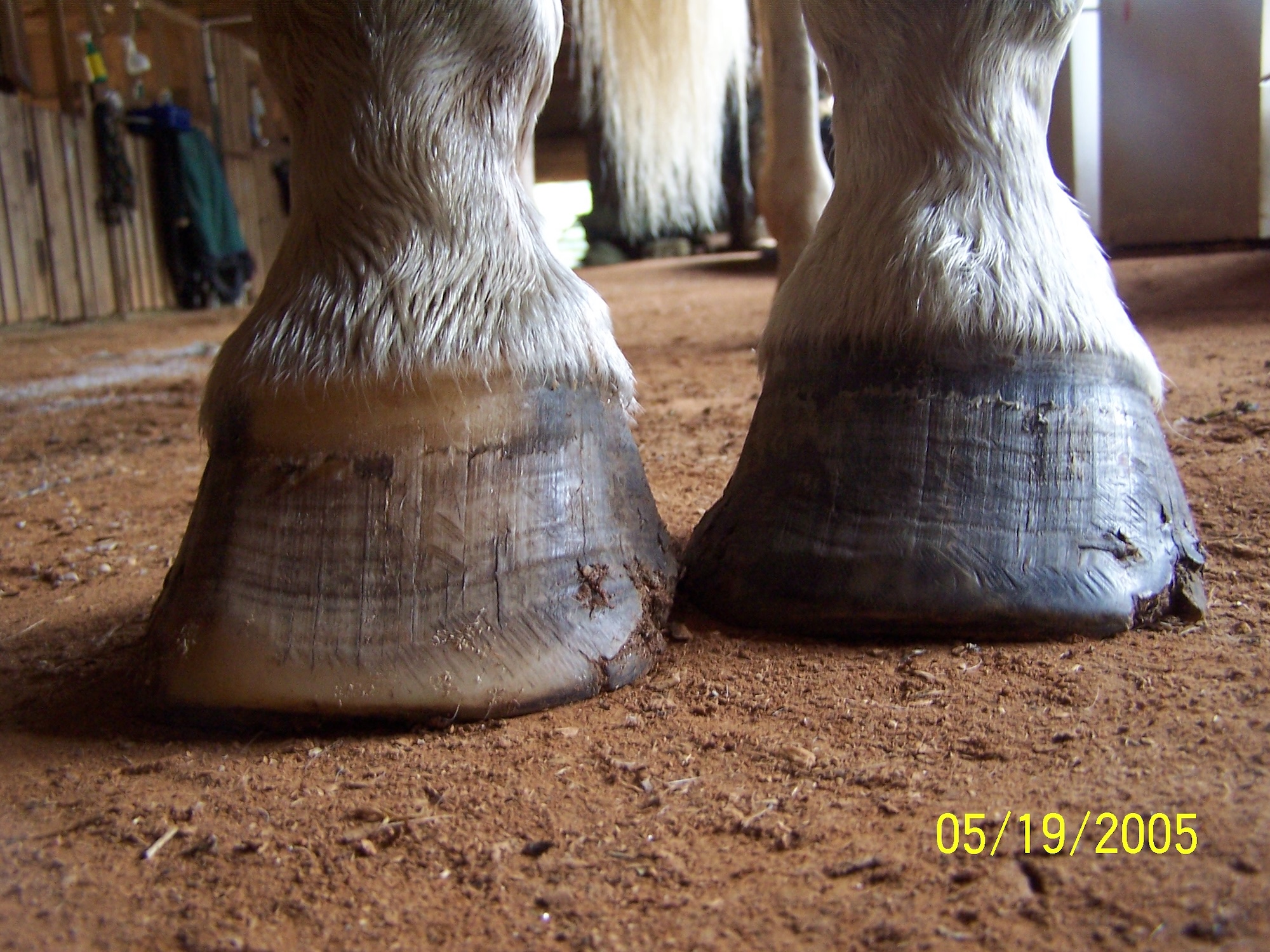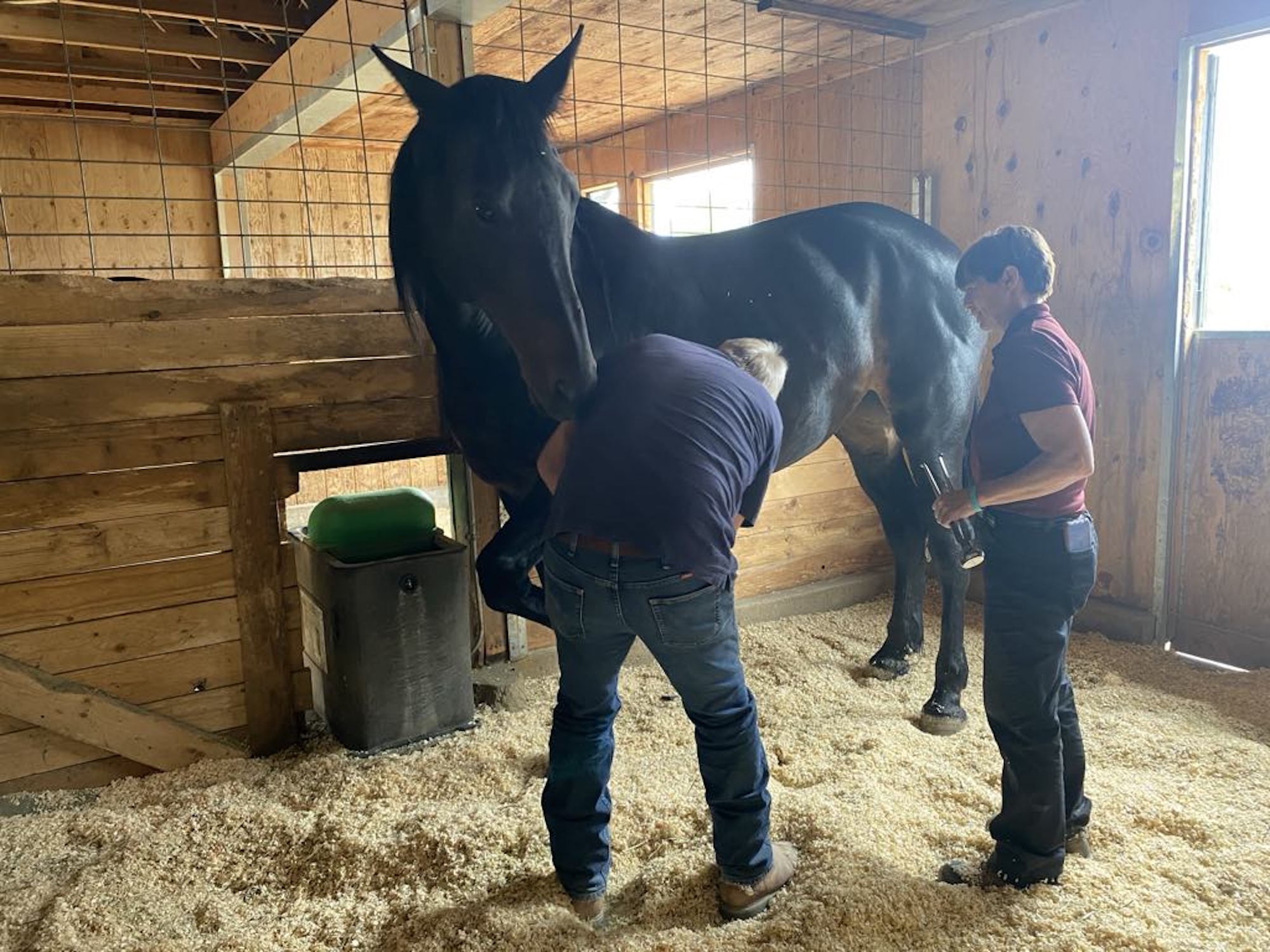It is very important that we start at the beginning. A paradigm is “a philosophical or theoretical framework,” and it basically represents the viewpoint from where to begin. This is our paradigm of the horse’s hoof.
This is our starting point. We did not “invent” most of these ideas—we were taught them by Dr. Hiltrud Strasser, Jaime Jackson, and Dr. Robert Bowker (notations where applicable). These ideas were either discovered by them through scientific study and observation, or were simply passed on from even older sources of deeper horse knowledge. (If you are a newcomer to the concept of keeping horses barefooted, good resources include the books, A Lifetime of Soundness by Dr. Strasser, and The Natural Horse and Horse Owners Guide to Natural Hoof Care by Jaime Jackson.) We have also developed some of our own ideas through practical experience and observation.
1. The hoof is a living part of the horse’s body.
The hoof is not a dead block of wood at the end of the horse’s leg. Rather, it is a sensitive and complex organ that feels tactile stimulus while providing protection of the internal structures. Horses’ hooves have evolved over 60 million years, from the five-toed Eohippus, into the modern single-toed Equus of today. The horse is a creature of flight, so natural selection favored the animal that could run the fastest. The modern hoof is simply a marvel of nature’s design.

There are more nerves in the foot than in the brain of the horse!(1) Sensory receptors on the bottom of the hoof—sole, bulbs, and frog—provide a wealth of sensations about the ground surface. The horse literally uses its feet to feel the ground, and to gain information about its environment, including whether a surface is comfortable or not.(2) Horses use these tactile sensations to negotiate their terrain, to keep their footing on slick surfaces, and to avoid stepping on sharp, hard objects that might cause injury. No, horses were not made to be unfeeling rock crushers—they will (and should) avoid stepping down hard on a sharp rock that might damage the hoof. This is important to their survival.
The inside of the hoof is highly vascular, containing many blood vessels. However, these blood vessels have a unique role in the equine hoof: haemodynamic shock absorption.(1)
There is far more blood flow in the hoof than is needed for tissue nourishment, so the vessels instead provide hydraulic energy dissipation. The veins in the foot are also critical for energy dissipation: horses’ veins are pulsating (this was an exciting discovery for Bowker)–blood does not actually pump out of the foot, but weightbearing does force blood out of foot.(1) Therefore, movement is crucial for blood circulation inside the hoof.
Hoof walls grow at the rate of about 1 cm per month in normal, healthy horses.(3) However, all hoof wall does NOT grow down from the coronet.(1) There is actually some hoof wall created by the migration of extra cells (from the laminae) happening below the coronet. This process allows for the hoof to adapt to pressures even after the wall has grown down. The foot moves and changes to relieve stresses; it is relatively soft and malleable.(1) This is crucial in regards to shaping the hoof through trimming.
The hoof capsule is an extremely effective insulator, protecting well against all extremes of severe heat and cold. The hoof shape is that of a truncated cone. Shock absorption is also provided through the hoof mechanism of the hoof capsule. This is the deformation and reformation of the hoof capsule upon weightbearing, then lifting of the hoof—the expanding and contracting of the entire hoof capsule.(3,5)
Around the age of 5, a healthy young horse with enough daily exercise should develop fibrocartilage in the back part of the foot—the heels and the digital cushion area, directly over the bars.(1) No horse is born with this fibrocartilage—the tissue must be stimulated through movement to develop this feature. This is one of the adaptive responses of the foot. All “good-footed” horses have this feature, along with other markers of health. Horses that do not develop this fibrocartilage (due to inadequate environment) become the “bad-footed” horses, leading to all sorts of degenerative hoof problems, but these horses can be rehabbed. The horse’s hooves change throughout its life, and are molded mostly through the environment.
2. In order to have genuinely healthy hooves, a horse really does need to be barefoot.
From the above paragraphs, it becomes obvious that the hoof is a sensory organ, highly adaptable, and made to expand and contract upon weightbearing. Shoes interfere with all of these functions. Shoes also have the high potential to contract and deform the hoof, create unnatural loads and strains on the horse, and pose greater risk of injury to horse and handler. Jackson’s and Strasser’s books(3,5,6,7) provide a multitude of reasons for going barefoot. However, it is often important to have even more scientific reasons to explain why barefoot is truly imperative for hoof health.

Probably the most convincing explanation for why hooves need to be bare is the argument of peripheral loading. “Peripheral loading” is a term that was invented by Dr. Robert Bowker to describe the physical situation of the hoof wall bearing the majority of the weight of the equine limb. Basically, “peripheral loading devices” are horseshoes! There is no currently known way to shoe a horse without putting the majority of the weight onto the walls of the hoof, thus removing load from the sole, frog and bulb.
Traditionally, it has been viewed that the horse should bear its weight on the walls. Bowker, not coming from an equestrian background, dared to question this—after all, there is no other hooved mammal that does not bear its weight on the pads of its feet. His scientific studies using Doppler Ultrasound provided the startling evidence: extreme peripheral loading, such as a regular horseshoe applied with the horse standing on a hard surface, reduces the blood perfusion in the horse’s hoof by 50% in a matter of minutes.(4) This means 50% less blood flow in the microvessels of the hoof! This alone has serious implications for the shock absorption and nerve function inside the hoof. With peripheral loading, blood flow STOPS for a moment (split second) with every heartbeat at the level of the horse’s fetlock. Corresponding with this, Bowker states that he has never seen a good-footed horse that was peripherally-loaded.(1)
It is very important to understand that peripheral loading (PL) can happen in a shod or a barefoot hoof. PL can happen in a barefoot hoof when the walls contact the ground primarily and/or if the ground is very hard and flat, which leads to less solar contact. PL is minimized by soft ground, or conforming ground (such as sand, deep dirt, mud, pea gravel). PL happens when most of the weight is born on the outer wall of the hoof. PL has severely negative effects on blood flow, but also has negative effects on the hoof wall and coronary corium, because the wall is malleable and changeable.
Bowker theorized from his studies that the outer wall was not meant to bear weight. However, we concluded this to be true from hard-earned practical experience on very PL terrain. We made our discoveries through observation, even before hearing Bowker’s theories, but he’s the one who gave us all the reasons why. One of our goals in trimming is to always minimize this peripheral loading, because it is one of the most damaging physical effects upon the hoof. Even if you live on softer terrain, a simple walk down a paved road will create PL in your horses’ hooves, immediately. We observe rapid improvements in hoof health in every horse that has its peripheral loading reduced.
In his studies, Bowker also observed that shoes prevent expansion and increase pressures inside the foot.(1) In addition, he did experiments counting the laminae in a variety of hooves, with the observation that the more laminae, the worse off the hoof was—these laminae would be weak. More laminae always showed up as a result of stressors, for example in areas of flares, or pressure points. Shod horses always had more laminae than barefoot horses.(1) Some of his recent studies point directly to peripheral loading as a cause of porous, unhealthy coffin bones—and osteoporosis of the coffin bone, usually unrecognized, is much more widespread than ever expected.(1,8) Most horses examined at necropsy have varying degrees of osteoporosis in the coffin bone.(8) Conversely, loading of the solar surface of the hoof leads to greater bone density, and healthier coffin bones.
3. The wild horse hoof remains the inspiration.
We believe it is important to constantly turn back to the “natural” hoof, because only in a hoof untampered with by man can we find its true form. However, there is no single model of a wild horse hoof! There are many examples of feral horse hooves that are quite unhealthy, or display inferior forms that we should have no desire to replicate in our own horses. It is important that we compare, observe critically, and appreciate the wild hooves that are showing evidence of good health.
Jaime Jackson observed that healthy form during his studies of wild hooves in the 1980’s.(5,6) These healthy mustang hooves from the Western U.S. Great Basin display the ideal natural shape: short toes, low heels, frogs & bulbs on the ground. Well-rounded walls that eliminate all peripheral loading pressures from the hoof. Sturdy, solid heel buttresses with bars that taper straight to end mid-point down the frog. There are many other examples of similar healthy wild horse hooves, and we have found all of our trimming questions answered by studying these feet.

However, in reality, there is no such thing as a “natural trim,” simply because trimming is never natural. Trimming is always man-made (which is why there has always been, and always will be, arguments over trimming). Horses living in perfect conditions may indeed self trim, but whenever a human picks up a tool, there is nothing natural going on! So the question remains: how best to recreate in our domestic horses the same strong hoof form which nature endows upon its wild ones? And most importantly, how to create this hoof without the prerequisite of wild horse living conditions?
4. Correct hoof form and a good living situation are the answer.
Dr. Strasser wrote, “Most of the common health problems and lamenesses afflicting domestic horses are a direct result of man-made violations of their natural lifestyle, and can be prevented or cured through a removal of the cause and a return to a natural lifestyle.”(3)
This statement reflects the leading principle of our paradigm. This simple tenet escapes most equestrians, and you can see that reflected in the material published by veterinarians and farriers, with advice that continuously overlooks the importance of hoof form, and our own ability to improve the horse’s life and prevent disease through correct management. You will observe that even the traditional paradigm can indeed make good recommendations: that horses should be fed forage continuously, receive as much turn-out and regular exercise as possible, be kept in herds, live outside, etc. The traditional paradigm, however, fails to hold owners accountable and responsible, and in the end, expects that horses will be stalled, shod, injected with drugs, ridden and trained poorly, patched together, used as vehicles, with hooves treated as dead blocks of wood to nail appliances onto, in order to prolong the useful life of the vehicle. None of this is acceptable, nor is it ever necessary. Prevention of health problems is relatively simple and easy.
We are not trying to make this sound too good to be true! You can’t fix everything, as horses already suffering from extreme pathology will show mixed results in rehabilitation. There are also genetic problems, metabolic disorders, and unexpected situations, as every horse is an individual. But for most horses, and most owners, there is a simple formula for equine health: 1) consistent barefoot trimming that creates a healthy hoof form; and 2) natural living conditions provided to the best of your abilities, as described in detail in Jackson’s and Strasser’s books.(3,5) Whenever you do encounter problems, the first step is always: identify and remove the cause.
References:
- Robert M Bowker, VMD, PhD, seminar “The Equine Foot for the 21st Century,” January 23-24, 2007.
- “Fingers, Frogs and Toes: Common Features!” by Robert M Bowker, VMD, PhD, The Horse’s Hoof Magazine Issue 34, page 4.
- “A Lifetime of Soundness” by Dr. Hiltrud Strasser & Sabine Kells.
Robert M Bowker, VMD, PhD, seminar “The Equine Foot for the 21st Century,” November 12-13, 2007. - “Horse Owners Guide to Natural Hoof Care” by Jaime Jackson.
- “The Natural Horse” by Jaime Jackson.
- “Shoeing: A Necessary Evil?” by Dr. Hiltrud Strasser & Sabine Kells.
- “Osteoporotic Coffin Bones” by Robert M Bowker and Tara Calvert-Jackson, VMD, PhD, The Horse’s Hoof Magazine Issue 35, page 6.
by James and Yvonne Welz, published 2011 Hoof Help Online & The Horse’s Hoof Magazine, Issue 43, Summer 2011
See the full content listing of all issues of The Horse’s Hoof Magazine! We also provide instructions on how to read the issues for free on Hoof Help Online.
For a detailed listing of all articles on The Horse’s Hoof website, please visit our Article Directory.




